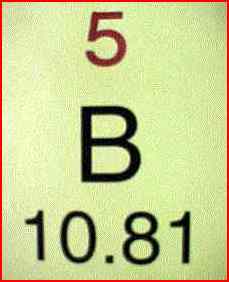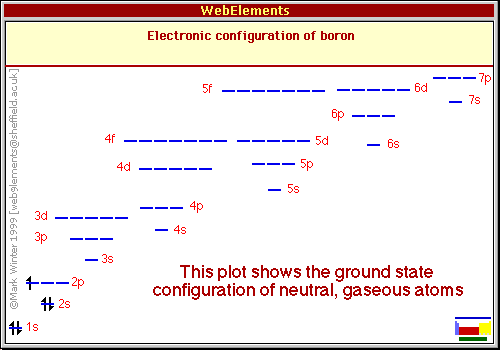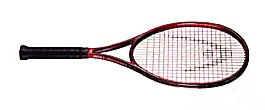
BORON
To comment on this page email me
| Element Symbol | B |
|
Atomic Number |
5 |
| Atomic Mass | 10.81 g |
| Common Oxidation States | +3 |
| Pauling electronegativity | 2.04 |
|
Standard State |
solid at 298 K |
| Color | black |
|
Ground State Electronic Configuration |
[He].2s2.2p1 |
|
Melting/Boiling Points |
2300 / 2550 deg. C |
|
Price-Crystalline, Amorphous |
$5/g, $2/g |

The first image below is a schematic representation of the shell structure of boron .

Boron is a Group 13 element. It has properties which are borderline between metals and non-metals. It is a semiconductor rather than a metallic conductor. Boron is a good conductor at high temps. but not at room temp. Chemically Boron is closer to silicon than to aluminum, gallium, indium, and thallium.
Crystalline boron is inert chemically and is resistant to attack by boiling HF or HCl. When finely divided it is attacked slowly by hot concentrated nitric acid.
solid state structure of Boron


boron is used in tennis rackets
Future
cars may have fuel spools not fuel tanks.
Photo courtesy of Textron Systems.
History: The element Boron was discovered in 1808 by Sir Humphrey Davy, Gay-Lussac, and Thenard. However, Boron came into existence through a serious of fragmentations reactions, called the X-process, billions of years ago!
Sources: Boron is not found free in nature. It occurs as orthoboric acid found in certain volcanic spring waters and as borates in boron and colemantie. The boron mineral Ulexite is nature's own version of "fiber optics."
Important sources of boron are ore rasorite (kernite) and tincal (borax ore). Both of these ores are found in the Mojave Desert. Tincal is the most important source of boron from the Mojave. Extensive borax deposits are also found in Turkey.